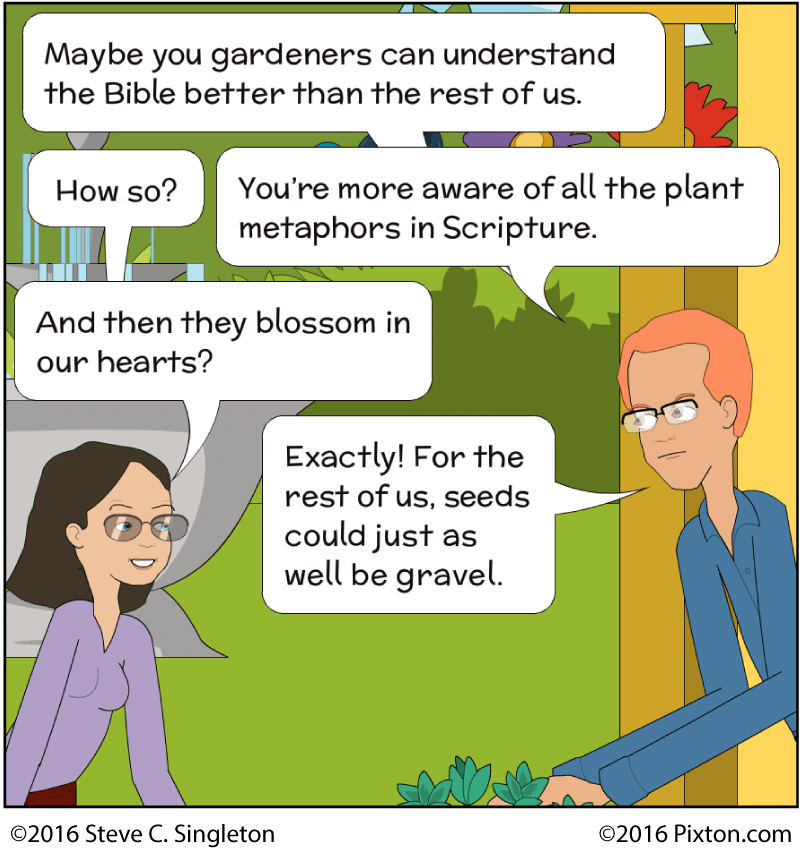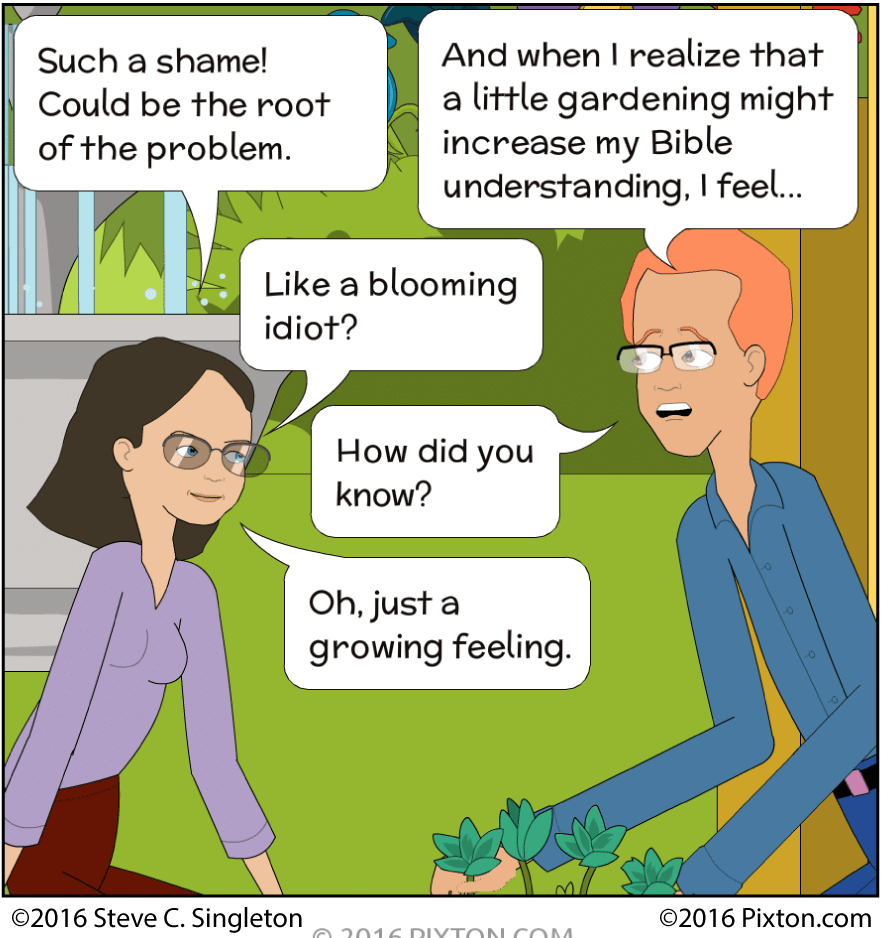Plant metaphors in the Bible: a tool for deeper study
Agricultural Metaphors in Scripture
Introduction: Farming as source of symbols of spiritual growth
When God’s messengers in the Old Covenant and the New wanted to explain the ways of the Lord to people, they looked around for objects and events familiar to them. Among the most familiar were the plants they lived with day by day and year after year. From the everyday experiences of sowing, plowing, watering, reaping, and storing the biblical authors created metaphors to explain the unseen realities of the spiritual realm.
The culture of the people of Palestine in both Old Testament and New Testament times was based on an agricultural economy. Even the Hellenistic-Roman culture of the first-century Mediterranean world, though greatly diversified and more urban, still had farming as its broad base. According to Borowski, the main crops were cereals such as various kinds of wheat and barley, as well as vegetables. Domesticated trees and vines yielded the olives, figs, the pomegranates, dates, and grapes. They also cultivated nut trees, yielding almonds, pistachios, and walnuts.
The subject of biblical agricultural metaphors is too wide a topic to cover in this post. What I can do is offer a few of the more important examples from each major section of the Bible to give you a sense of the kind of imagery that we are considering. Hopefully, this sampling will mark out for you a path to follow as you investigate the dozens of other similar metaphors on your own.
Metaphors in the Law
Genesis
Blessing to Isaac – Gen. 26:12
Isaac’s life takes up little space in Genesis, but this statement is remarkable. The record says, “Isaac planted crops in that land and the same year reaped a hundredfold.” Considering that in ancient times a typical yield was three times what was sown and a tenfold yield considered a bumper crop, only a miraculous blessing from the Lord could account for a harvest so bountiful. Jesus apparently alludes to this when He speaks of the multiplying harvest of God’s word: 30, 60, or 100, 60 times what was sown (Mark 4:8; Matt. 13:8; Luke 8:8).
One crop per field – Lev. 19:19; Deut. 22:9
In Leviticus, God demanded that the Israelites devote each field to only one kind of seed. At the close of the wilderness wanderings, He repeated this ordinance in Deuteronomy, but with more specifics: “Do not plant two kinds of seed in your vineyard. If you do, not only the crops you plant but the fruit of the vineyard will be defiled.”
This command, joined to several others of a similar nature regarding two kinds of draft animals or two kinds of cloth, apparently was a lesson about holiness. God did not want His people to suppose that they could serve Him and idols in a syncretism that was so common then, and now. He wanted them to think of moral absolutes in terms of a binary: either serve Him or idols, but not both.
Sabbatical year – Lev. 25:20, 22
God commanded that Israelites that after six years of planting and reaping, in the seventh year they should leave their fields unplowed, unsown, and unharvested. This command had three functions. First, it was an opportunity for God to demonstrate His abundant blessing to them. They could survive on His bounty without having the seventh year’s harvest. Second, the crops that grew up on there own that year were dedicated to the needy of the community: the widows, the orphans, and the foreigners living in the land. Third, we now know that there was an agricultural value to letting the land lie fallow one year out of seven. It prevented the people from depleting the nutrients in the soil.
Agricultural blessing – Lev. 26; Deut. 28
In the blessings of the covenant, Moses promised that if the people would be faithful to serve the Lord alone, He would bless them in every way, including their crops, their livestock, their children, their finances, and their military campaigns. If, however, they were unfaithful to the Lord, nothing they touched would escape His punishment.
In the “Former Prophets” (historical books)
Symbols of God’s grace – Josh. 24:13
When the Israelites settled in the land of Canaan, God fulfilled His promises to them, granting them peace and security. This is expressed by this statement that summarizes God’s grace to them: “I gave you a land on which you did not toil and cities you did not build, and you live in them and eat from vineyards and olive groves you did not plant” (compare Deut. 6:10-11). God’s blessing allowed them to skip the lean, start-up years characterized by major effort with little or no return for all their labor.
Judges 9:8-15 – Allegory of the thornbush
Jotham speaks to the citizens of Shechem, rebuking them for making his brother Abimelech their king. After being crowned, Abimelech had killed all of his 70 brothers; only Jotham survived by hiding. He compares the Shechemites to trees who ask an olive tree, then a fig tree, and then a grapevine to be their king. As a last resort, they ask a thornbush, who accepts.
The refusals of the first three trees give us an insight into the agrarian system operational at the time. The olive tree asks, “Should I give up my oil, by which both gods and men are honored, to hold sway over the trees?” (v. 9). The fig tree asks, “Should I give up my fruit, so good and sweet, to hold sway over the trees?” (v. 11). The grapevine asks, “Should I give up my wine, which cheers both gods and men, to hold sway over the trees?” (v. 13). All three expect a negative answer. (Keep in mind that this context is dealing with a society in apostasy from God, as indicated by the polytheistic assumptions.)
Solomon’s encyclopedia – 1 Kings 4:33
In detailing the wisdom of King Solomon, the author of Kings says, “He described plant life, from the cedar of Lebanon to the hyssop that grows out of walls. He also taught about animals and birds, reptiles and fish.” This virtual encyclopedia that Solomon wrote pre-dated the more famous one of Aristotle by several hundred years.
In the “Latter Prophets” (prophetical books)
The literary prophets, whose ministries began in the eighth century BCE, often used the farming operations surrounding them as illustrations of their preaching and prophecies. Here are a few examples.
Allegory two eagles and a vine – Ezekiel 17
The prophet Ezekiel tells an allegory in which an eagle snips off and carries away the tiptop sprig of a cedar of Lebanon, and planted it in a merchant city. Then he took seed from Palestine and planted it in fertile soil beside plenty of water, where it sprouted and grew into a lush vine. Toward another eagle with powerful wings and plenty of feathers it sent both its root and its boughs, seeking water.
The two eagles represent the ruler of Babylon and the ruler of Egypt. The top of the cedar represents the king of Judah deported to Babylon, and the planted seed is the man appointed as governor for the Babylonian overlord. Although the governor has plenty of support from Babylon, he starts seeking help and support from Egypt. God’s message is that this is a mistake: seeking help from Egypt will only bring trouble to the governor and to his people.
Allegory of the vineyard – Isaiah 5:1-7; Jeremiah 2:21 (compare Psalm 80:8-16)
The psalmist complains that the same God who carefully planted and cultivated the nation as His vineyard has now abandoned it to the wild beasts. He prays for the Lord to renew His interest in His vineyard.
Isaiah portrays the kingdom of Judah as a vineyard God has planted and cultivated with care. He expects good fruit from His vineyard, the fruit of justice and righteousness. Instead, he finds sour grapes: bloodshed and cries of distress. Like a disappointed vineyard owner, God threatens to tear apart and abandon His vineyard.
Jeremiah makes a parallel comparison, mourning that the choice vine of Judah has become a corrupt and wild one.
Recall of covenant grace – Isaiah 37:30; 65:21-22; Jeremiah 29:5, 28; Ezekiel 28:26; Amos 9:14
The planting of vineyards and gardens and then enjoying their produce is a graphic way of indicating that the people will no longer be on the move. Under God’s blessing they will no longer be refugees with no permanent place to live.
Recall of covenant wrath – Isaiah 65:22; Micah 6:15; Zephaniah 1:13
When His people turn their backs on God, He gives them what He promised as punishment for their rebellion: others would enjoy the benefit of all of their farming and building labor.
In the wisdom books
Prosperity – Job 8:16; 14:9
Job’s friend Bildad employs the withering of a plant in the hot sun to symbolize the person who forgets God. Job takes the opposite—the revival of a cut-down tree at the first hint of moisture—to serve as a stark contrast with the plight of human beings, whose loss in death is irreversible.
Righteous sustained by God – Psalm 1:3-4
The contrast between a tree, continually sustained by a stream of water beside it, and chaff, so dry that it lacks the weight needed to avoid being blow away by the wind, is the difference between the righteous and the wicked. The former have God as their continual source of renewal; the latter have only themselves and will soon perish.
Prosperity/disaster – Eccl. 3:2
Planting and uprooting not only applies literally, but also serves as a metaphor for positive and negative actions toward individuals, groups, and even nations. Every action has its proper place and time, according to the set order of Providence.
In the gospel accounts
Among the variety of parables, similes, and metaphors in the body of His teaching, Jesus drew many illustrations from the everyday life of the people in rural Galilee, Samaria, Perea, and Judea. Farmers figure prominently among Jesus’ dozens of parables.
Growth of the kingdom – Mark 4 and parallels in Matthew 13 and Luke 8
Some of the most famous of his parables are the Parables of the Kingdom. Jesus promises that the message of the kingdom will reproduce itself many times over what is sown, making up for the loss due to people never responding, people falling away because of persecution, and people distracted from kingdom business due to concern for riches or anxieties about the troubles of the world (Mark 4:3-9, 13-20).
In another parable (Matthew 13:24-30, 36-43), He contrasts the kingdom children with the children of the evil one – the wheat and the darnel (weeds that look like wheat until the time of harvest). The angels gather the former at the judgment, but consign the latter to the fire.
Additional plant-parables include the seed growing of itself without any additional work required between planting and harvest (Mark 4:26-29) and the growth of the mustard seed, far beyond what its diminutive size would lead us to expect (Mark 4:30-32).
Expectations for Israel – Luke 13:6-9
Jesus speaks of a fig tree planted in an ideal spot but still fruitless. Before cutting it down, the caretaker gains permission to give it one last chance to bear fruit after receiving an application of fertilizer.
Jesus’ willingness to die – John 12:24
When Jesus hears that some Greeks want to meet Him, Jesus says, “Unless a grain of wheat dies, it remains only a single seed, but if it dies it produces many seeds.” He takes this as a sign that the hour of His death has arrived, adding, “But I, when I am lifted up from the earth will draw all people to myself” (John 12:32).
Jesus the true vine – John 15
As a way to illustrate His disciples’ dependence on him, He compares Himself to a grapevine, of which His disciples are the branches. The purpose of the owner of the vineyard (God the Father) is to manage the vineyard to produce as much fruit as possible. To accomplish this, He carefully prunes the branches so that each of them can be as productive as possible.
In the Epistles
Two olive trees – Romans 11
Tree-grafting is the focus of Paul’s illustration to show the distinctions between the Jews who accept Jesus as Messiah, the Jews who reject Him, and the Gentiles who are prompted to accept Him when they witness the unbelief of some of the Jews. His concern is to show both that the believing Gentiles become grafted in to the true Israel and that those unbelieving Jews, who are broken off, cease to be of the true Israel anymore. A third point is that the dead branches lying around at the base of the tree can be grafted in again “if,” Paul says, “they do not persist in their unbelief.” He warns the believing Gentiles, however, that they can be severed from Israel if they do not persist in believing. In the end everyone remaining a part of the cultivated olive tree belongs to Israel, while everyone either broken off or not grafted on will be lost. “Thus,” Paul concludes, “all Israel will be saved” (Romans 11:26), that is, all who remain connected to the life-giving sap of the stump.
Evangelism – 1 Corinthians 3:6
Paul calls himself, Apollos, and perhaps others “God’s coworkers,” and he calls the Corinthian Christians “God’s field” (1 Corinthians 3:9). He says, “I planted the seed. Apollos watered it, but God made it grow. So neither he who plants nor he who waters is anything, but only God, who makes things grow” (1 Corinthians 3:6-7).
The resurrected body – 1 Corinthians 15
Just as the plant that sprouts is different from the seed that was planted and just as God can assign a different ‘body’ to each kind of plant, He is capable of assigning a body to the human being raised from the dead that is different from the body “planted in the ground” at death (1 Corinthians 15:35-38). Paul then makes a series of contrasts between the body that is “planted” and the body that emerges from the grave (1 Corinthians 15:42-45).
The moral cause-effect linkage – Galatians 6
Paul uses the connection between sowing and reaping to remind the Galatian Christians that the actions they “sow” have moral consequences at the spiritual “harvest.” God has established this sow-reap principle as fundamental to the moral fabric of the universe, and “God,” Paul reminds them, “cannot be mocked.” Sowing to the flesh will produce a carnal harvest: corruption. Sowing to the Spirit will produce a spiritual harvest: eternal life (Galatians 6:7-8).
Coming of death – James 1:11; 1 Peter 1:24 (quoting Isaiah 40:6-8)
As the hot sun scorches the moisture out of a plant, causing it to wither, human beings quickly die.
God’s word – James 1:21; 1 Peter 1:23 – 2:3
When a person responds to the gospel, God plants His imperishable Word in that person’s heart. It has the capacity to save the person that meekly receives it. James urges the new Christian to focus intently on the Word and actively respond to it. Peter says to get rid of everything in the way of Christian growth, drink in the Word, and “grow up in your salvation.”
In Revelation
Harvest as judgment against evil – Revelation 14:14-16 (see Joel 3:13; Matt. 13:30)
John compares the coming judgment to a wheat harvest and a grape vintage. Neither the wheat nor the grapes can avoid the sickle; judgment is inevitable.
Fruit tree of life – Revelation 22:2, 19 (Ezekiel 47:7, 12)
The water of life flows through the New Jerusalem, and along its banks grows the Tree of Life, whose leaves are for the healing of the nations and whose fruit, newly ripe each month, is freely available to every citizen of the city of God. From anyone who omits words from the Revelation prophecy God will take away their share in the tree of life.
What is the common thread?
In nearly all of these passages and the many more that we could examine, one common thread seems to be the idea that plant life illustrates a process of change that nevertheless contains within it a remarkable degree of continuity. The life that exists within all plants comes from God, going back in an unbroken chain to His powerful, spoken word during creation (see Genesis 1:11-12). A flourishing plant or conversely a plant wilting in the scorching sun is a strong metaphor for human life and human death. Because God is the provider of this plant life and the manager of all of the vicissitudes on which it depends (sunlight, moisture, temperature, pests, weeds, etc.), its survival is a powerful image of His providence and His grace, repeated over and over in Scripture.
Want to go deeper?
For further reading:
George E. Post. Flora of Syria, Palestine, and Sinai. Beirut, Syria: Syrian Protestant College, 1896.
Gives a brief, scientific description of virtually all plants in Palestine, Syria, and Sinai. Very comprehensive.
Borowski, Oded. “Agriculture.” 1:95-98 in Anchor Bible Dictionary. 6 vols. David Noel Freedman, ed. New York: Doubleday, 1992.
Provides a thorough discussion of the farming methods and crops of both Old Testament and New Testament agrarian economies.
“Farming.” 269-272 in Dictionary of Biblical Imagery. Leland Ryken, James C. Wilhoit, and Tremper Longman III, eds. Downers Grove, Ill.: InterVarsity, 1998.
Discusses many of the farming imagery in both Old and New Testaments.



